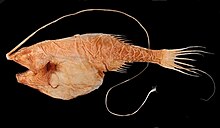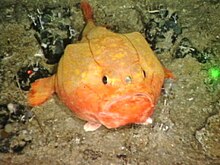Deep sea frogfish
| Deep sea frogfish | ||||||||||||
|---|---|---|---|---|---|---|---|---|---|---|---|---|

Deep-sea frogfish from different families: |
||||||||||||
| Systematics | ||||||||||||
|
||||||||||||
| Scientific name | ||||||||||||
| Ceratioidei | ||||||||||||
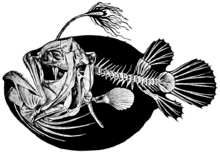
The deep-sea frogfish or deep-sea anglers (Ceratioidei) are a suborder of deep-sea fish and with around 160 species the most species-rich taxon of the vertebrates in the bathypelagial (1000 to 4000 meters depth).
They occur in all oceans below a depth of 300 meters. The deep-sea frogfish consist of eleven different families and belong to the order of the armfinches (Lophiiformes). In contrast to all other armfinches that inhabit the bottom, deep-sea frogfish live pelagic .
Apart from morphological investigations on dead catches, the deep-sea anglerfish have been little researched. Observations on live fish are rare.
distribution
Deep sea frogfish are found in the deep sea of all oceans, from the Arctic Ocean to the Southern Ocean . Some species have a worldwide distribution, while the distribution area of others is very small and very limited both spatially and vertically. In the meso - (200 to 1000 meters depth) and bathypelagial (1000 to 4000 meters) they are the main carnivorous and ecologically important.
features
Deep-sea frogfish are clumsy fish with bloated bodies, large heads and large mouths with long fangs. In most cases the body is scaly, but the skin can be covered with papillae or spines. Females reach body lengths between 6 cm and 1.2 m. Deep-sea frogfish are usually dark brown to blackish in color; the skin of the genus Haplophryne from the Linophrynidae family is unpigmented and transparent. The palatine and basihyale, an element between the hyoid bones, are absent in adult females. The pseudobranch is also missing, only remains of a few Gigantactis species are left. The supraoccipital, a skull bone, lies centrally behind the frontalia and between the parietals . The Frontalia did not grow together. The lower pharyngealia are reduced and toothless. Deep-sea frogfish have 19 to 24 eddies.
Deep-sea frogfish show extreme sexual dimorphism and thus differ from their benthic (bottom dwelling) relatives in the armfinch order. The tiny males ( dwarf males ), which were initially thought to be larvae or fry, often only reach 5 to 10 percent of the female size. At Ceratias holboelli , the females are sixty times larger than the males and, with a maximum length of 1.20 meters, are the largest deep-sea anglers, and about 500,000 times heavier than the males. Females have a "fishing rod" ( Illicium ) with attached "bait" ( Esca ), which is usually equipped with a light organ . In females, luminous organs can also be present in other places. A swim bladder is missing.
The fin formula is the same for male and female deep-sea frogfish. It is very variable within the superfamily. For most families:
Dorsal 3–8, anal 3–7, pectoral 12–30, ventral 2–5, caudal 9.
Deviating from this, the Neoceratiidae have 11 to 13 fin rays in the dorsal fin and 10 to 13 in the anal fin. In the Melanocetidae there are 12 to 22 fin rays in the dorsal fin, in the Caulophrynidae likewise, and 5 to 19 in the anal fin. Ctenochirichthys has 28 to 30 pectoral fin rays. The caudal fin has 8 fin rays in Cryptopsaras and 10 in Neoceratiidae. It is rounded in almost all families, in large individuals of the Ceratiidae it ends in round, skin-covered ossifications. Ventral fins are absent in adult deep-sea anglerfish and are only present in the larvae and shortly after metamorphosis in the Caulophrynidae. Pelvic bones are absent or reduced. The rays of the unpaired fins are sometimes greatly elongated, especially in the females of Caulophrynidae and Gigantactinidae , and are often not connected by a fin membrane, or the fin membrane is extremely thin and transparent.
All fins are only supported by soft rays, a dorsal fin supported by fin spines is missing. The first dorsal fin spine is converted into a "fishing rod" ( Illicium ) with attached "bait" ( Esca ) and is located on the top of the head. The second is reduced to a tiny residue and overgrown by skin, partly also grown together with the upper side of the fin support and lying directly behind the Illicium. Both dorsal fin spines are supported by a single fin support.
female
The body of the females is usually rounded and short, but elongated and laterally flattened in the Thaumatichthyidae , Centrophrynidae , Ceratiidae, Gigantactinidae, Neoceratiidae and some Oneirodidae. The head usually takes up more than 40 percent of the standard length , but only a quarter in the elongated species. As with other armfinches, the mouth is extremely large. The length of the premaxillary ranges from 10 percent of the standard length in some Gigantactinidae to 40 percent in some Linophrynidae . The mouth gap is almost horizontal in Thaumatichthyidae, Centrophrynidae and Gigantactinidae, almost vertical in Melanocetidae and Ceratiidae. Gill raker beams are on the branchial arches II and III as Holobranchien (branchial arches, the respiratory both at the front and the rear side of filaments wear) available, ranging in some families (Caulophrynidae, Himantolophidae , Melanocetidae, Diceratiidae some oneirodidae , Centrophrynidae and Neoceratiidae) as Hemibranchia (respiratory filaments only on one side) also on gill arches I and IV.
male
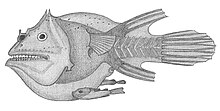
Males are only a few inches long in most cases. Miniature males from the Linophrynidae family only reach a length of 6 to 10 mm and are therefore among the smallest vertebrates at all. They are even smaller than the carp-like of the genus Paedocypris and the goby-like of the genus Schindleria . The body of the deep-sea angler males is elongated, the head is shorter than 40 percent of the standard length, the length of the premaxillary is less than 15 percent of the standard length. The mouth is horizontal. The cephalad dorsal fin spines that form the esca in females are greatly reduced, the remains are covered by skin; Illuminating organs are missing. The eyes and olfactory organ are greatly enlarged in most species. The latter are used to track down the species-specific pheromones that are released by the females. The normal teeth are lost during metamorphosis and are replaced by hook-shaped teeth in the tip of the snout, which are used to bite into the female's skin.
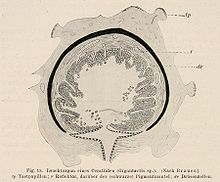
Luminous organs
Female deep-sea frogfish differ from their relatives living in shallower sea regions, e.g. B. the frogfish (Antennariidae), which live mainly in coral reefs , through the possession of a luminous organ on the Esca, which acts as a prey dummy. Only the females of the Caulophrynidae family, the Gigantactiniden genus Rhynchactis and those of Neoceratias spinifer are without luminous organs. The shape, size and number of attachments and filaments of the Esca are an important feature to distinguish the different species from one another.
The internal structure of the Esca is intricate and includes a bewildering variety of vesicles filled with luminescent bacteria, light absorbing layers, pigments , reflective tissues, tubular light conducting structures, nerves, blood vessels and muscle fibers. There is some evidence that the Esca also contains pheromone- producing glands that serve to attract males.

In addition to the light organ of the Esca, all species of the genus Linophryne (Linophrynidae) have a complex barb on the hyoid bone (hyoid). The light of the Bartel does not come from light-producing bacteria, but from photogenic granules lying between the cells. The light organ of the hyoid barbel developed from the mesoderm , while the light of the esca is produced by bacteria practically outside the body. The independent development of two different light-producing mechanisms in the genus Linophryne is unique in the animal world.
"Sex Parasitism"

In some families and genera - the Caulophrynidae, Ceratiidae, Neoceratiidae, Linophrynidae and the Oneiroden genera Bertella and Leptacanthichthys - the partner's skin and bloodstream grow together; the males from then on live firmly connected with the females.
Permanent growth occurs through two separate outgrowths from the tip of the male's upper and lower jaw, both of which eventually fuse with the female's skin. In some species, the female's skin grows into the male's mouth and eventually lines the entire throat. This creates an elongated, cylindrical stalk with which the male is attached to the female tissue. In other species, the heads of the males can also merge with the skin of the females over a large area - from the tip of the lower jaw to the back of the skull. From then on they are completely unable to feed themselves and, like embryos in the uterus of mammals, are nourished by the female's bloodstream. Grown dwarf males clearly increase in size, also compared to the length of free-living males of the same species. They spawn with the females and die with the death of the females. In many species, one dwarf male per female is the norm; in others it can be several. The record of observed specimens is eight dwarf males on one female.
The growth has been known since the 1920s and is referred to as sex parasitism in many Anglo-Saxon publications , but has nothing to do with actual parasitism . The physiological processes that allow the process to take place have not yet been researched and could be important for biomedicine , immunology and endocrinology . According to current research, the protein defense in fish with sexual parasitism is not pronounced.
External system
Of the five main taxa of the armfinch, the deep-sea frogfish are the most phylogenetically derived . The relationships according to a recent study shows the following cladogram :
| Armfinch (Lophiiformes) |
|
||||||||||||||||||||||||
|
|
Internal system

The sub-order of the deep-sea frogfish includes about 160 species from eleven families. The following cladogram shows all families and the probable relationships to one another:
| Ceratioidei |
|
|||||||||||||||||||||||||||||||||||||||||||||||||||||||||
|
|
Others
Discovered in the Gulf of Mexico, Lasiognathus dinema has been named the ugliest new species out of 18,000 species first described in 2015.
swell
Most of the information in this article comes from the web site of the frogfish expert Theodore W. Pietsch at the Tree of Life Web Project . In addition, the following sources were used:
literature
- Kurt Fiedler: Fish (= textbook of special zoology. Vol. 2: Vertebrates. Part. 2). Gustav Fischer, Jena 1991, ISBN 3-334-00338-8 .
- Joseph S. Nelson : Fishes of the World. 4th edition. John Wiley & Sons, Hoboken NJ et al. 2006, ISBN 0-471-25031-7 .
- EO Wiley, G. David Johnson: A teleost classification based on monophyletic groups. in Joseph S. Nelson, Hans-Peter Schultze, Mark VH Wilson: Origin and Phylogenetic Interrelationships of Teleosts. Publishing house Dr. Friedrich Pfeil, Munich 2010, ISBN 978-3-89937-107-9
Web links
- Theodore W. Pietsch & Christopher P. Kenaley: Ceratioidei. Seadevils, Devilfishes, Deep-sea Anglerfishes , 2007 ( The Tree of Life Web Project )
- Hildegard Kaulen: Immune system of deep sea fish: Until death do them part. In: FAZ.net . August 8, 2020 .
Individual evidence
- ^ MP Black, MS Grober: Group sex, sex change, and parasitic males: sexual strategies among the fishes and their neurobiological correlates . In: Annual Review of Sex Research . tape 14 , no. 1 , 2003, p. 160–184 ( online (PDF; 3.4 MB)).
- ↑ Sexual parasitism with medical relevance - Wissenschaft.de . In: Wissenschaft.de . July 30, 2020 ( Wissenschaft.de [accessed August 2, 2020]).
- ↑ DeepFin.org: New and Revised Classification for Bony Fishes based on Molecular Data - version 2 ( Memento of the original dated December 12, 2013 in the Internet Archive ) Info: The archive link was inserted automatically and has not yet been checked. Please check the original and archive link according to the instructions and then remove this notice. (November 27, 2013)
- ↑ Masaki Miya, Theodore W. Pietsch, James W. Orr, Rachel J. Arnold, Takashi P. Satoh, Andrew M. Shedlock, Hsuan-Ching Ho, Mitsuomi Shimazaki, Mamoru Yabe, Mutsumi Nishida: Evolutionary history of anglerfishes (Teleostei: Lophiiformes): a mitogenomic perspective. In: BMC Evolutionary Biology , Volume 10, No. 1, Feb 2010, p. 58. doi : 10.1186 / 1471-2148-10-58 .
- ↑ http://science.orf.at/stories/2775782/ Schaurig, schön und skurril, orf.at, May 23, 2016, accessed May 23, 2016.
